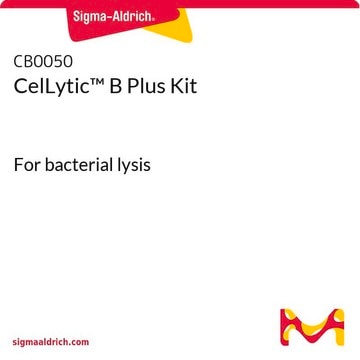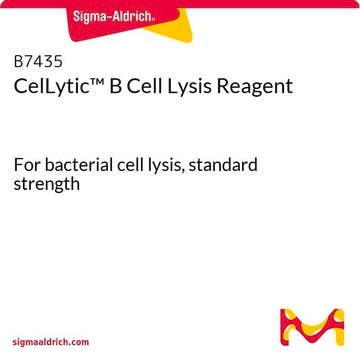For efficient nucleic acid removal using Benzonase® (E1014), the recommended ratio depends on the concentration of DNA or RNA in the sample. A typical starting point is 25 U/mL of Benzonase® for reducing nucleic acid content in lysates, which corresponds to approximately 1 unit of enzyme per 37 µg of DNA under optimal conditions. For lower concentrations of DNA or RNA, as little as 9 U/mL may achieve 99% removal, but higher concentrations, e.g., 90 U/mL, ensure faster and more complete degradation. Optimal activity requires 1–2 mM magnesium ions, a pH of 8.0–9.2, and incubation at 37°C. Adjustments may be needed for sample-specific factors such as buffer composition and nucleic acid load.
E1014
Benzonase® Nuclease
≥250 units/μL, ≥90% (SDS-PAGE), recombinant, expressed in E. coli, buffered aqueous glycerol solution
Synonym(s):
Endonuclease from Serratia marcescens
About This Item
Recommended Products
biological source
Serratia marcescens
Quality Level
recombinant
expressed in E. coli
Assay
≥90% (SDS-PAGE)
form
buffered aqueous glycerol solution
mol wt
30 kDa
concentration
≥250 units/μL
application(s)
research use
foreign activity
protease, essentially free
shipped in
wet ice
storage temp.
−20°C
Looking for similar products? Visit Product Comparison Guide
General description
Application
Biochem/physiol Actions
Features and Benefits
- Host DNA depletion in microbiome samples.
- Effective nucleic acid digestion in a variety of workflows.
- Viscosity reduction during protein extraction.
Unit Definition
Physical form
Legal Information
Storage Class Code
10 - Combustible liquids
WGK
WGK 1
Flash Point(F)
Not applicable
Flash Point(C)
Not applicable
Personal Protective Equipment
Choose from one of the most recent versions:
Certificates of Analysis (COA)
Don't see the Right Version?
If you require a particular version, you can look up a specific certificate by the Lot or Batch number.
Already Own This Product?
Find documentation for the products that you have recently purchased in the Document Library.
Customers Also Viewed
Articles
Benzonase® Nuclease for reducing host DNA in microbiome workflows and enhancing taxa identification.
Benzonase® Nuclease for reducing host DNA in microbiome workflows and enhancing taxa identification.
This page lists nine frequently asked questions and answers about Benzonase® Nuclease.
This page lists nine frequently asked questions and answers about Benzonase® Nuclease.
Related Content
The use of Benzonase® endonuclease can significantly reduce the levels of DNA by more than 100,000-fold while also reducing viscosity and protecting downstream equipment from DNA fouling. However, optimization strategies and DoE are critical when it comes to reducing DNA in your process. Setting up a DoE for your Benzonase® endonuclease application can help you find the optimal operation conditions that deliver the required DNA clearance from your process.
The use of Benzonase® endonuclease can significantly reduce the levels of DNA by more than 100,000-fold while also reducing viscosity and protecting downstream equipment from DNA fouling. However, optimization strategies and DoE are critical when it comes to reducing DNA in your process. Setting up a DoE for your Benzonase® endonuclease application can help you find the optimal operation conditions that deliver the required DNA clearance from your process.
The use of Benzonase® endonuclease can significantly reduce the levels of DNA by more than 100,000-fold while also reducing viscosity and protecting downstream equipment from DNA fouling. However, optimization strategies and DoE are critical when it comes to reducing DNA in your process. Setting up a DoE for your Benzonase® endonuclease application can help you find the optimal operation conditions that deliver the required DNA clearance from your process.
The use of Benzonase® endonuclease can significantly reduce the levels of DNA by more than 100,000-fold while also reducing viscosity and protecting downstream equipment from DNA fouling. However, optimization strategies and DoE are critical when it comes to reducing DNA in your process. Setting up a DoE for your Benzonase® endonuclease application can help you find the optimal operation conditions that deliver the required DNA clearance from your process.
-
Hi, what is the ratio of E1014 : DNA and E1014 : RNA for an efficient acid nucleic removal?
1 answer-
Helpful?
-
-
How many ul does it contain? What kind of Unit is KU?
1 answer-
The unit activity of this product is lot-specific and reported in the product Certificate of Analysis. The minimum activity is 250 units per microliter. The KU value represents 1000 units. For example, a 20 KU package size represents 20,000 units. Please see the link below to review a sample or lot-specific Certificate:
https://www.sigmaaldrich.com/product/sigma/e1014#product-documentationHelpful?
-
-
Hi, for protein purification from E. coli cells, how much is the working concentration range for Benzonase nuclease (≥250 units/μL)? Thank you
1 answer-
The recommended starting concentration for Benzonase nuclease is 25 units per milliliter of cell lysate.
Helpful?
-
-
Hello, I plan to do proteomic for protein. When I add RIPA buffer to isolate the protein, I need to remove the DNA and RNA inside. When should I add E1014? Together with RIPA or after it?
1 answer-
Concentrations greater than 1 mM EDTA will inhibit Benzonase activity, and RIPA buffer recipes typically contain EDTA at higher concentrations than 1 mM. Therefore, Benzonase should be used after removing EDTA from the lysed sample or consider using a different lysis solution that does not include EDTA in the formulation.
Helpful?
-
-
What is the storage temperature range for E1014? There is only a specified storage temperature, and not a range.
1 answer-
This product is stored at freezer temperature, which is typically -20°C. An excepted range is -15 - -20°C.
Helpful?
-
Active Filters
Our team of scientists has experience in all areas of research including Life Science, Material Science, Chemical Synthesis, Chromatography, Analytical and many others.
Contact Technical Service








